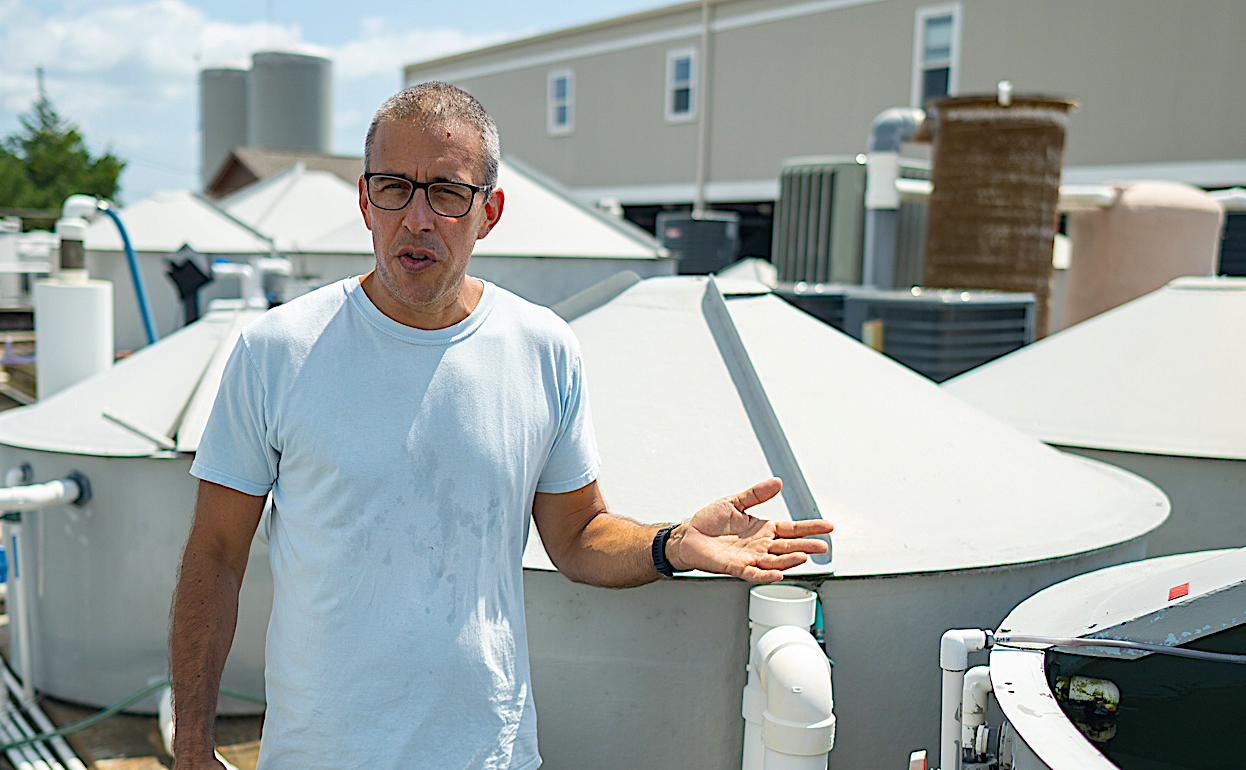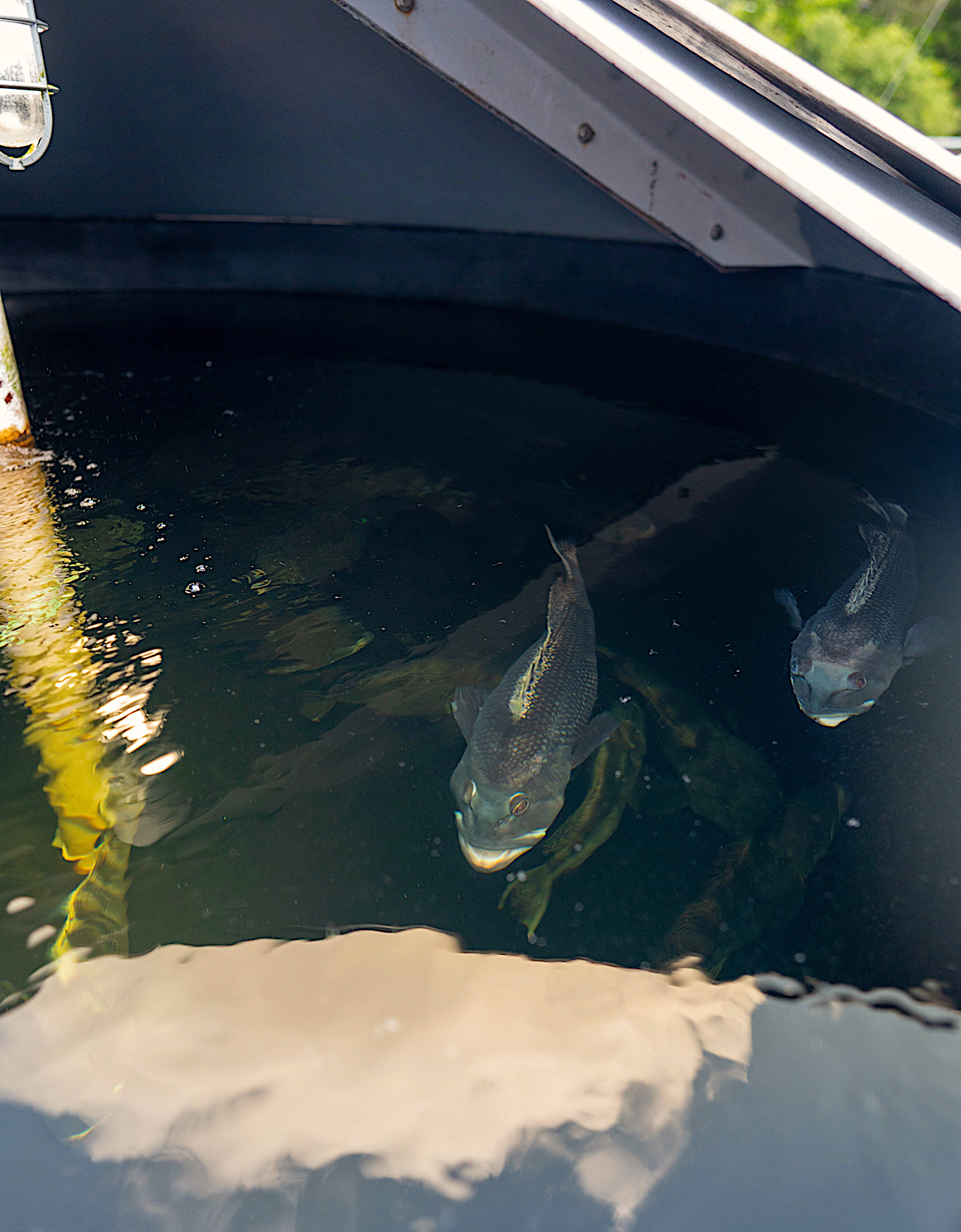Is There a Profitable Market for Farm-Fresh Black Sea Bass?

Thanks to aquaculture breakthroughs from a team at UNCW, this seafood favorite could reach more consumers.
If you’ve been fortunate this summer to make it out fishing on hard-bottomed areas, including shipwrecks and reefs, you might have landed a black sea bass. This North Carolina favorite feeds on crabs, clams, and shrimp, which gives it a firm, white flesh and a delicate and sweet flavor — ideal for a variety of cooking techniques.
Research Need
Both market demand and dockside wholesale prices have increased for black sea bass. Fishery managers, however, have determined that while the Mid-Atlantic stock is above their targets, the South Atlantic stock is not. As such, management agencies have implemented more stringent fishing regulations that limit current and future landings.

There is interest in developing commercial production of black sea bass among private growers in several states, including our own. With support from North Carolina Sea Grant and several other funders, long-term comprehensive research at the University of North Carolina Wilmington (UNCW) has ranged from controlled breeding of larvae and juvenile production in hatcheries to grow-out (tending fish up to harvest sizes) in recirculating aquaculture systems.
The results have been promising — and have shown that black sea bass can be bred in captivity — but researchers also wanted to evaluate production considering market and economic factors to determine if black sea bass is commercially ready for farming.
What did they study?
The research team built a pilot hatchery that used laboratory-based research at commercial scale to provide startup fish farmers with a source of fingerlings — fish less than a year old and about the size of a human finger.
Based on all the costs associated with operating the pilot hatchery, the scientists conducted an analysis, using a fixed set of economic conditions, of a hypothetical full-scale commercial black sea bass hatchery operation. The team made several assumptions in their calculations: project life was 30 years, with equipment replacement every 10 years, and the capacity of the hatchery was 100,000 advanced-stage fingerlings. The team also fixed other business-related factors (e.g., interest rates, land ownership, staffing, etc.).
What did they find?
For the hypothetical, commercial-scale hatchery, total initial investment costs of facility construction, recirculating systems, and hatchery-wide equipment and installation are $778,527. Variable operating costs total up to $71,426 per year, including labor expenses. Fixed operating costs, which account for loan interest and other expenses, total $23,162 per year.
Breakeven price per 5-gram fingerling is $1.67 but a mere $0.43 for a 1-gram fingerling. Both of these prices are highly sensitive, requiring an efficient, fruitful harvest every time.
High-value retail markets provide prices that could be much more profitable for startup growers, though. While wholesale prices for whole-on-ice black sea bass depend on size, with higher prices per pound for larger fish, growers can target niche markets for ultra-fresh product, which garner premium prices for fish of assorted sizes.
Anything else?
Not only are black sea bass easy to catch in the wild, they adapt well to life in aquaculture tanks — even though female broodfish change sexes to male, usually when they reach 9 to 13 inches at 2 to 5 years old. This means aging males must be replaced with wild-caught females.
Over the years, UNCW researchers have made numerous discoveries that have advanced techniques for farm-raising the species. For instance, by manipulating the amount of exposure to daylight and using hormone treatments they could induce the females to ovulate. Early fingerlings — weighing less than 1 gram on average — are “transport-ready,” with excellent resistance to acute crowding and shipping. The team learned how to control infections during grow-out, too, by lowering water temperatures.
They also determined how to rear black sea bass larvae through juvenile stages using standard feeding regimens for marine finfish. Additionally, they found that using their own UNCW-formulated diets (which replaced 50% fish meal protein with poultry meal protein) led to better growth in early juvenile fish than two commercial diets, without adverse effects on survival.
So what?
The UNCW team’s results have been promising. They successfully bred black sea bass in captivity, raised the species from egg to adult stages, and found that black sea bass can reach lucrative niche markets.
Availability of fingerlings from UNCW’s hatchery has enabled startup farmers to grow and market black sea bass, but commercial expansion will require investment in research to lower production expenses. Research is needed to lower feed and fingerling costs, increase growth, minimize size variation, maximize fish densities in grow-out systems, and address waste management.
Reading
Watanabe, W.O., Carroll, P.M., Alam, M.S., Dumas, C.F., Gabel, J.E., Davis, T.M., and Bentley, C.D. 2021. The status of black sea bass, Centropristis striata, as a commercially ready species for U.S. marine aquaculture. Journal of the World Aquaculture Society. 52:541–565. DOI: 10.1111/jwas.12803
Funding support came from USDA-National Institute of Food and Agriculture, NOAA Marine Aquaculture Program, Marine Biotechnology in North Carolina, North Carolina Sea Grant, and Southern Regional Aquaculture Center, Saltonstall-Kennedy Grant Program, Cotton Incorporated, New Hanover County Farm Bureau, and Friends of UNCW.
By Sara Mirabilio
Lead photo: Patrick M. Carroll, supervisor of UNCW’s Aquaculture Facility, gives a tour of the tanks on-site. Credit: Dan DiNicola.
The text from Hook, Line & Science is available to reprint and republish at no cost, but only in its entirety and with this attribution: Hook, Line & Science, courtesy of Scott Baker and Sara Mirabilio, North Carolina Sea Grant.
- Categories:



